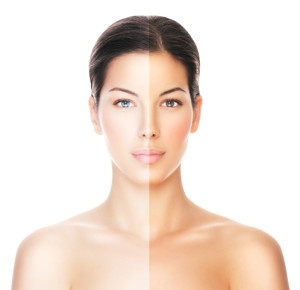Self-Tanning
Self-Tanning Products
Today, many prefer to get beautiful tan without putting their skin at risk. Self-tanning products are designed to do exactly that. More precisely, it’s Dihydroxyacetone (DHA) and erythrulose that do the job. Consumers who want to beautifully and safely tan, prefer a bottle of self-tanner to direct outdoor sun exposure or to tanning in indoor sun beds.
Dihydroxyacetone is made of glycerine which is colorless sugar that also exists in the human body. Glycerol reacts with the skin’s free amino acids and proteins. The bonding of inverted sugars with proteins has come to be known as “Maillard Reaction”. When a Maillard Reaction takes place brown color pigments are produced. This is a type of melanin.
The reaction occurs immediately when the self-tanning agent is applied to the skin. The artificial, sunless tan shows after about one to three hours. Depending on the skin type: the light-resistant tanning effect is preserved for three to five days.
The skin is being continuously renewed during the process of cell division and cell renewal, in which dead skin cells gradually and naturally flake off as dry skin flakes to make room for new ones. This is the reason why the tanning effect gradually disappears. After about ten days the skin is back to what it looked like before self-tanning lotion or spray was applied to it.
This form of self-bronzing is harmless and should not entail any unpredicted long-term effects, according to present knowledge. The type of skin tan that self-tanning agents achieve does not protect against UV rays. Contrary to natural sun tanning through Melanin build-up during the tanning process, skin that has been tanned through a glycerol-tan does not provide any sunray protection. This is why it is advisable to make use of sun screen products with a high sun protection factor und a balanced UVA protection, or to use a self-tanning product that is enriched with UV filters.
Erythrulose is another self-tanning agent which is also a form of sugar that is extracted through a biotechnological process. It is chemically a lot more robust than Dihydroxyacetone. Consequently, the self-tanning process takes a longer time and the tan itself does not become visible within a few hours but rather after one or two days. Self-tanning processes with glycerol or erythrulose do not affect living skin cells but only impact corneous cells inside the corneal layer (epidermal stratum corneum) that don’t have a cell nucleus anymore.
How to get the perfect tan?
If you want to receive a beautiful tan without streaks, it is advisable to do a body peeling 24 hours prior to applying a self-tanning lotion. This will ensure that superfluous corneous cells are removed and that the surface area of the skin is homogenous. Very dry skin patches need to be treated with moisturizing lotion. Otherwise the Glycerol will move too deep into the skin and will turn out a streaky tan. It you want to self-tan your face, it makes sense to glide with an ice cube over your face before your apply the self-tanning agent. As a result, the pores close you are more likely to receive an even tan.
What are the drawbacks of Dihydroxyacetone?
There are drawbacks though: one of them is that Dihydroxyacetone in cosmetic products disintegrates over time. The decomposition products of Dihydroxyacetone (e.g. hydroxyl methylglyoxal, formaldehyde, glycolic acid, formic acid, acetic acid, pyruvic acid) do not only tint for brown skin but decrease the skin’s PH value (<3) as well resulting in a pungent and sometimes even penetrating smell of the cosmetic formulation.
The best-before-date (BBD) is very important for self-tanning products because they can be made to fit the life cycle of the product, thus avoiding more complicated formulation strategies and storage solutions. The unfavorable smell that is mostly perceived as acrid pong discourages consumers to continue to use the product, once it is past its date of expiry. In order to encourage consumers to continue to buy self-tanning products, it is essential to find a work-around solution in order to prolong the decomposition of Dihydroxyacetone and to cover and conceal possible scents or by-scents.
If you are anticipating the development of a self-tanning product or are already in the process of developing one but need an optimization of the olfactory model, get in contact with us. After all, nobody likes smelly cosmetics. And we can make your product look good, feel good and smell good – and above all: yield a beautiful natural brown colour. A best ever self-tan.
We can support you to develop the sun tanning product you need for the market you want to reach.
